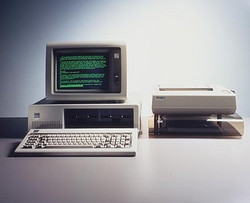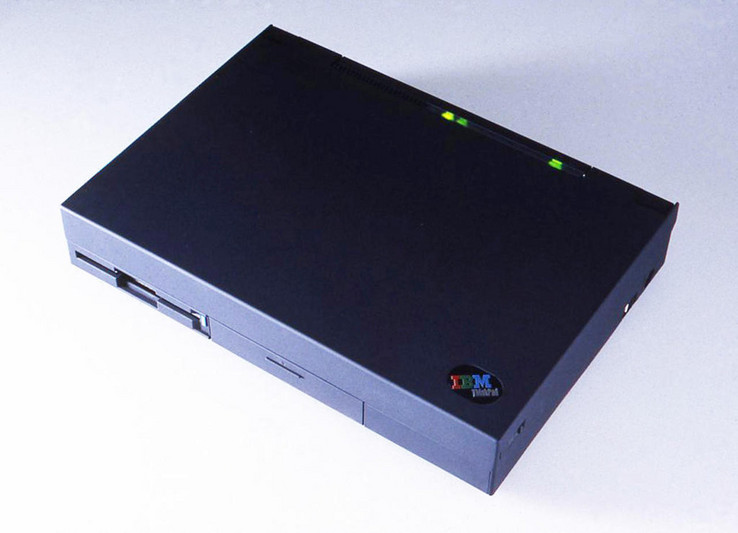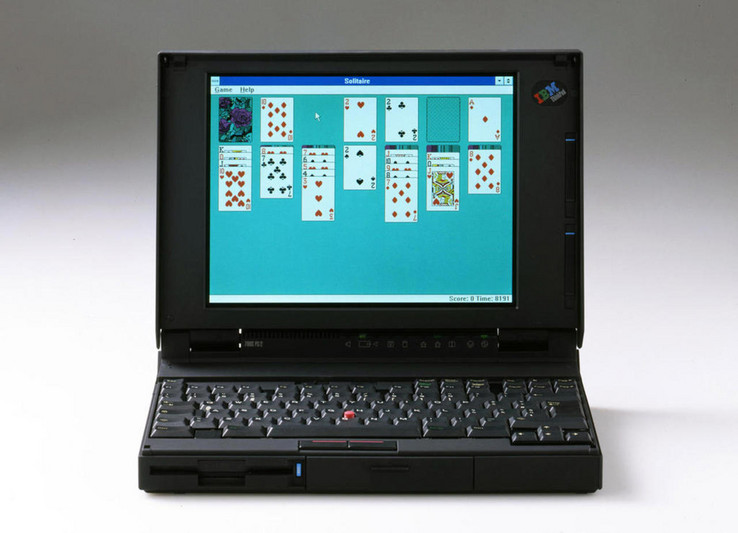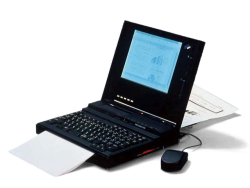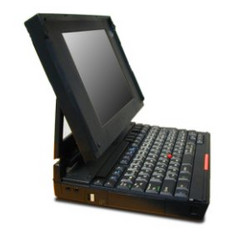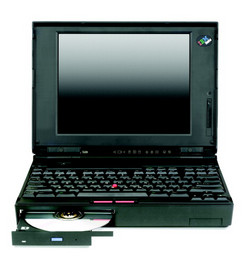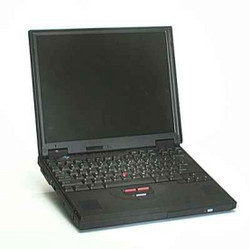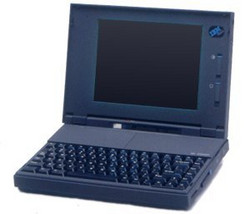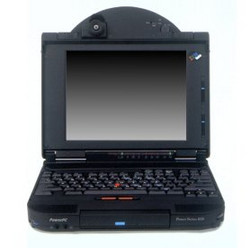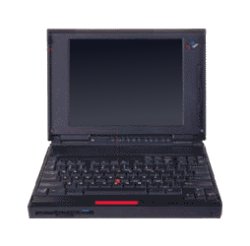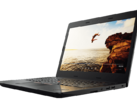A look back at 25 years of ThinkPad notebooks: Part 1 - the beginnings with IBM
For the original German article, click here.
When we talk about the age of a dog, we often use dog's years to compare its age with that of a human. The same is the case for technology: One dog year goes a lot faster than one human year. Three years of technological development can mean enormous changes while a human only changes minimally within the same three years.
25 years, however, is almost an eternity, both for technology and for humans. 25 years are a quarter of a century and more than a quarter of an average human lifetime. 25 years ago, the cold war had only just been put behind us and Bill Clinton was about to be elected president.
In short, 1992 is quite a while back. The world of technology looked very different; the PC revolution was in full swing and hardly any of the brands that existed then still exist today - they have been swallowed up by the constant technological revolutions and market upheavals. Some of the companies that did manage to keep going - and quite successfully, in fact, are the large industrial institutions such as Microsoft or Apple; Windows still exists, too, although it looked completely different then. But there are not that many computer brands that have managed to survive: one example would be the brand "TravelMate", which now belongs to Acer and was first developed by Texas Instruments.
But TravelMate never reached the prominent position that another brand, that also existed in 1992, did: the ThinkPad. The ThinkPad brand has overcome crises and changes of direction in the PC market and has nonetheless managed to stay true to itself (for the most part). We would like to take the brand's 25th birthday as an occasion to take a closer look at how it all happened and why the ThinkPad developed a cult status.
The Crisis before the ThinkPad
As so often is the case, the story of success was born out of a crisis. By the beginning of the 80s, the original ThinkPad manufacturer IBM had established its IBM PC as the general standard for home computers - but they could not rest on their laurels for long: Around the end of the 80s and beginning of the 90s, a new category of PC entered the market: portable computers. IBM had difficulty finding a place in this newly-developed market and was being overtaken by its competition. The company was considered a clumsy giant that was not able to act fast enough. The largest competitor of the time was Compaq, a company that was later taken over by Hewlett-Packard in 2002.
At the beginning of the 90s, the focus moved from bulky portable PCs to laptops and notebooks. IBM had already produced several PCs in the clamshell form, for example the IBM PS/2 L40SX. The manufacturer had started testing some technologies in this device, which were later used for the ThinkPads. The PS/2 notebook was not a break-through, however, and further developments under the PS/2 name were considered me-too products by the press and not taken seriously. In order to really gain a foothold in the new market, IBM needed a new product that would re-establish the company as the leading innovator.
The Beginning: The ThinkPad 700C
This new product was the ThinkPad 700C. This computer combined all technical developments of the early 90s. One of the most important technical aspects of the 700C was the display: at this point, small, monochrome 9.5-inch displays were still the general standard, but the ThinkPad 700C was equipped with a 10.4-inch color display and had a very compact form - for those days at least. From today's perspective, it might seem strange that the display was the most important feature of the first ThinkPad notebook, but then it was IBM's guarantee for success.
But not only technical aspects were important for the success of the ThinkPad; marketing played a big role as well. It started with the name: "ThinkPad" was a big step away from IBM's previous naming patterns. Had it been a normal product, IBM would have promoted it as a PS/2 notebook with some complex string of numbers at the end. However, the PC management team decided to go with the name "ThinkPad", a name that IBM had already used before the 700C for an unsuccessful tablet, the IBM 2521 ThinkPad. The tablet with an input pen was a flop, but the name - which was based on IBM's old company slogan "THINK" - was a success.
Marketing includes a recognizable design. The original ThinkPad design was created by the German industrial designer Richard Sapper, who died in 2015. In a time when most PC cases were made of the typical beige plastic, Sapper decided that the ThinkPad should be black. Today, black is considered the boring color, but then it was radically new for PCs. Richard Sapper chose the Japanese bento box as a model for the ThinkPad's shape. The black color and angular, edgy case were supposed to make the ThinkPad stand out from the masses even when it was closed.
Once you opened the device, you were welcomed by the great keyboard typical for IBM. But the 700C also had something else to offer - a completely new design feature: the (now iconic) TrackPoint which enabled moving the mouse key without taking your hands off the keyboard. The TrackPoint was not invented for the ThinkPad specifically, but the ThinkPad is where it was first really put to use. The IBM developer Ted Selker originally developed the TrackPoint in the 80s. Its typical look with a red rubber button comes from Richard Sapper. The TrackPoint was originally supposed to be blue, following IBM's company color. But again, the ThinkPad managed to get away with going against IBM's bureaucratic principles, which reserved the color red for emergency-off buttons. Sapper was convinced that the TrackPoint must be red, as this creates the highest contrast to the black case. So he said it would be produced in magenta - but, surprisingly, the button then came out of production as red.
The Success and Successors of the 700C
Design, brand name, technology - everything fit for the ThinkPad 700C. IBM had simply managed to produce the right product at the right time. When it was finally presented on October 5th 1992 at the computer expo COMDEX (since discontinued), the reactions of visitors and the media were very positive. The ThinkPad 700C did not invent the notebook, but it set a new standard for them. The ThinkPad 700C became a bestseller and IBM had difficulties keeping up with production. Even George Bush wanted a ThinkPad as a Christmas present for his wife and had to call up IBM PC management in order to get one.
After the success of the 700C, IBM began to develop follow-up models. Since it would take too much time to go into detail about every ThinkPad of the 90s, we have decided to just mention a few of the ThinkPad highlights that came after the 700C.
IBM ThinkPad 550BJ
This ThinkPad was sold only in Asia, but was special because it had an integrated Canon printer. Nowadays, a lot of people run a completely paperless office and manage very well - thanks to e-mails and PDFs.
But that was still unthinkable in 1993, or at least only as a far-off vision for the future. An integrated printer in your notebook was definitely an interesting concept, even if it is a little outdated by today's standards.
IBM ThinkPad 360P
One of the first ThinkPad notebooks that was both a notebook as well as a tablet. That makes it the ancestor of today's convertibles such as the Lenovo ThinkPad X1 Yoga or the ThinkPad Yoga 370. It was launched in 1994.
Unlike today's convertibles, the 360P did not flip 360° to the bottom of the base unit. The display itself was turned over and laid onto the keyboard. The screen was not operated with a finger, but with a pen. So really, the 360P is also a successor of the first PC that had the name of ThinkPad - the IBM 2521 ThinkPad we mentioned earlier.
IBM ThinkPad 755CD/CDV
This model was first presented in October 1994 and is interesting for two reasons: The first is that it was the first ThinkPad - the first notebook in general - that was equipped with an integrated CD drive. Previous ThinkPads still used floppy disk drives, but these were replaced by CD drives during the multimedia revolution that began in the middle of the 90s.
The model 755CDV offered another feature that seems archaic by today's standards: The back display cover could be removed and the display laid beneath an overhead projector. Overhead projectors were used for presentations a lot, so the 755CDV offered companies and schools the possibility of creating computer-supported presentations via an overhead projector.
IBM ThinkPad 701C "Butterfly"
This is one of the most well-known and iconic ThinkPads. The 701C with the nickname "butterfly" had a keyboard that automatically unfolded when the display was flipped open. This was necessary because the displays were still too small for full-sized keyboards in those days. Instead of using a smaller keyboard, IBM developed a complex solution that would satisfy its customers.
The design of the 701C became so famous that it was included in the collection of the Museum of Modern Art. The commercial success of this concept was then put to an end by the development of larger displays, which made the foldout keyboard superfluous.
The following video from Lenovo shows the ThinkPad 701C "Butterfly" in action:
IBM ThinkPad 600
Unlike the models we have mentioned above, the ThinkPad 600 did not offer any particularly innovative features. Nonetheless, it is a significant ThinkPad: In 1998, IBM decided to move on from the bento box design with the ThinkPad 600. Until then, this design had been used for all successors of the 700C. Now, the case became slimmer, the wrist rest longer and the display grew to 13.3 inches.
The shape of the ThinkPad 600 is very similar to the shape of a modern notebook, particularly to the ThinkPad T series. This should not come as a surprise as the ThinkPad 600 is the series' forefather. The 600 became known for its high price, brilliant workmanship and excellent keyboard.
IBM's ThinkPad Fails
But IBM was not perfect. Every success comes with some drawbacks and the ThinkPads were no exception. Here are the two biggest failures of the early IBM era:
IBM ThinkPad 300
IBM made a big mistake right at the beginning: The IBM ThinkPad 300 was the first low-end ThinkPad and was announced together with the ThinkPad 700C. You would not expect it to be a ThinkPad judging by its looks - it was gray instead of black and did not have a TrackPoint.
But what was more of a problem was that the ThinkPad 300 did not work properly. Almost the entire production was dead on arrival. The ThinkPad 300 was not produced by IBM, but by the manufacturer Zenith. The flop of the ThinkPad 300 was a lesson for IBM and the manufacturer ended its cooperation with Zenith and quickly discontinued the ThinkPad 300. IBM was lucky to have launched the ThinkPad 700C at the same time, and that that model was such a great success. This prevented greater damage to the young brand.
IBM ThinkPad 800 Series
It is a well-known fact that Apple successfully used PowerPC CPUs in its PowerBooks until 2005. But not so many people know that IBM also produced PowerPC notebooks. This is not surprising considering that the ThinkPad 800 series notebooks such as the ThinkPad 820 and 850 were not successful. The 800 series was first launched in July 1995 and the experiment was stopped a year later.
PC history might look quite different as the PowerPC architecture could have successfully challenged Intel's monopoly on the PC market. But the flop of the ThinkPad 800 series only further reinforced IBM's dependence on Intel.
Verdict: The 90s – the Golden Age of ThinkPads
You still hear occasional disparaging remarks, saying that the design of the ThinkPads has remained stuck in the 90s. And IBM would have really been happy had the ThinkPad brand kept up the same success it had in the first years. The 90s were the best and most innovative times of the ThinkPad brand, which was also due to the continual growth of the notebook market. It was a golden decade - not just for IBM, but for the entire notebook segment. The main customers in the 90s were businesses and wealthy private individuals that could afford expensive notebooks - the perfect audience for ThinkPads.
The innovations and successes of this time created the ThinkPad brand that we know today. IBM continued to build on the design of the 700C and never lost sight of the roots of the ThinkPad brand. The innovations that ThinkPads have brought did not rely on a single person, but rather on the successful cooperation of different people and different teams.
But the first premonitions of coming crises could be seen by the end of the 90s. We will talk about the years from 2000 to 2010 in part two of our series.



